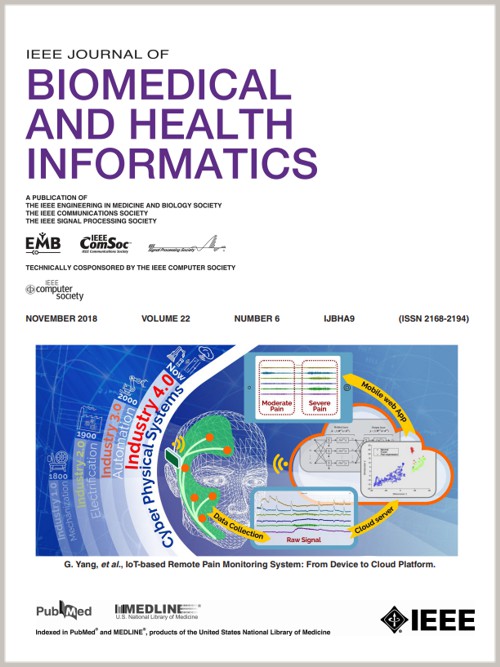基于超声波图像和对比增强超声波视频的甲状腺结节诊断双分支跨模态注意力网络
IF 6.7
2区 医学
Q1 COMPUTER SCIENCE, INFORMATION SYSTEMS
IEEE Journal of Biomedical and Health Informatics
Pub Date : 2024-10-02
DOI:10.1109/JBHI.2024.3472609
引用次数: 0
摘要
对比增强超声(CEUS)能以无创方式显示器官和病变中微血管的分布和循环情况,因此已被广泛用作甲状腺结节诊断的成像模式。然而,目前基于 CEUS 的甲状腺结节诊断方法存在以下问题:1)CEUS 视频中结节与其他解剖结构之间的空间边界模糊;2)仅从 CEUS 视频中提取的特征不能充分反映结节组织的局部结构信息。在本文中,我们提出了一种新型双分支网络,该网络具有跨模态关注机制,可通过整合两种相关模态(即 CEUS 视频和超声图像)的信息来诊断甲状腺结节。该机制包括两个部分:US-attention-from-CEUS transformer (UAC-T) 和 CEUS-attention-from-US transformer (CAU-T)。因此,该网络模仿人类放射科医生的方式,将诊断分解为两个相关任务:1) 利用 UAC-T 将从 CEUS 提取的时空特征分层嵌入从 US 提取的空间特征中,以进行结节分割;2) 利用 CAU-T 将 US 空间特征用于指导 CEUS 时空特征的提取,以进行结节分类。这两项任务在双分支端到端网络中相互交织,并采用多任务学习(MTL)策略进行优化。我们在收集的甲状腺 US-CEUS 数据集上对所提出的方法进行了评估。实验结果表明,我们的方法达到了 86.92% 的分类准确率、66.41% 的特异性和 97.01% 的灵敏度,优于最先进的方法。作为对多模态疾病诊断领域的一项普遍贡献,所提出的方法提供了一种将静态信息与其相关动态信息相结合的有效方法,提高了基于深度学习的诊断质量,并具有可解释性的额外优势。本文章由计算机程序翻译,如有差异,请以英文原文为准。
A Dual-Branch Cross-Modality-Attention Network for Thyroid Nodule Diagnosis Based on Ultrasound Images and Contrast-Enhanced Ultrasound Videos
Contrast-enhanced ultrasound (CEUS) has been extensively employed as an imaging modality in thyroid nodule diagnosis due to its capacity to visualise the distribution and circulation of micro-vessels in organs and lesions in a non-invasive manner. However, current CEUS-based thyroid nodule diagnosis methods suffered from: 1) the blurred spatial boundaries between nodules and other anatomies in CEUS videos, and 2) the insufficient representations of the local structural information of nodule tissues by the features extracted only from CEUS videos. In this paper, we propose a novel dual-branch network with a cross-modality-attention mechanism for thyroid nodule diagnosis by integrating the information from tow related modalities, i.e., CEUS videos and ultrasound image. The mechanism has two parts: US-attention-from-CEUS transformer (UAC-T) and CEUS-attention-from-US transformer (CAU-T). As such, this network imitates the manner of human radiologists by decomposing the diagnosis into two correlated tasks: 1) the spatio-temporal features extracted from CEUS are hierarchically embedded into the spatial features extracted from US with UAC-T for the nodule segmentation; 2) the US spatial features are used to guide the extraction of the CEUS spatio-temporal features with CAU-T for the nodule classification. The two tasks are intertwined in the dual-branch end-to-end network and optimized with the multi-task learning (MTL) strategy. The proposed method is evaluated on our collected thyroid US-CEUS dataset. Experimental results show that our method achieves the classification accuracy of 86.92%, specificity of 66.41%, and sensitivity of 97.01%, outperforming the state-of-the-art methods. As a general contribution in the field of multi-modality diagnosis of diseases, the proposed method has provided an effective way to combine static information with its related dynamic information, improving the quality of deep learning based diagnosis with an additional benefit of explainability.
求助全文
通过发布文献求助,成功后即可免费获取论文全文。
去求助
来源期刊

IEEE Journal of Biomedical and Health Informatics
COMPUTER SCIENCE, INFORMATION SYSTEMS-COMPUTER SCIENCE, INTERDISCIPLINARY APPLICATIONS
CiteScore
13.60
自引率
6.50%
发文量
1151
期刊介绍:
IEEE Journal of Biomedical and Health Informatics publishes original papers presenting recent advances where information and communication technologies intersect with health, healthcare, life sciences, and biomedicine. Topics include acquisition, transmission, storage, retrieval, management, and analysis of biomedical and health information. The journal covers applications of information technologies in healthcare, patient monitoring, preventive care, early disease diagnosis, therapy discovery, and personalized treatment protocols. It explores electronic medical and health records, clinical information systems, decision support systems, medical and biological imaging informatics, wearable systems, body area/sensor networks, and more. Integration-related topics like interoperability, evidence-based medicine, and secure patient data are also addressed.
 求助内容:
求助内容: 应助结果提醒方式:
应助结果提醒方式:


